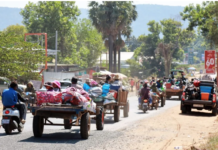Torrential rains and rising floodwaters have left more than 50,000 people stranded across eastern Australia, as a relentless storm system continues to batter the region for a second consecutive day, claiming at least two lives and prompting a large-scale rescue effort.
Emergency services launched dramatic air and ground rescues on Thursday, with residents climbing atop cars, rooftops, and bridges to escape fast-rising floodwaters. Two bodies were recovered from floodwaters in the Mid North Coast region of New South Wales (NSW), while authorities continued searching for two more missing persons.
The floods, which have submerged roads and isolated entire towns, were triggered by storms that dumped over half a year’s worth of rain in just three days. “We’re bracing for more bad news in the next 24 hours,” NSW Premier Chris Minns warned. “This natural disaster has been terrible for this community.”
The town of Kempsey, located along the swollen Macleay River, was abruptly cut off. Its mayor, Kinne Ring, described the ongoing rain as “deafening and horrible,” adding that more than 20,000 residents in her area were now isolated.
Further south in Taree, resident Jeremy Thornton called the experience “gut-wrenching.” “We are reliving it every second, hearing the rain, hearing the helicopters, hearing the siren,” he said.
Extraordinary rescue efforts included the winching of an elderly couple from their car roof by helicopter and the evacuation of residents from a highway bridge by a Royal Australian Navy Seahawk. Meanwhile, dead livestock were spotted washed up on beaches, carried downstream by flooded rivers.
The federal government has declared the situation a natural disaster, enabling greater access to emergency resources. About 2,500 personnel, supported by boats, helicopters, and drones, have been deployed.
The Bureau of Meteorology warned that some rivers had not yet peaked, though rainfall was expected to ease by Thursday night. Spokesman Steve Bernasconi said some areas had recorded over half a metre of rain in just three days.
Experts say abnormally warm ocean temperatures surrounding Australia have intensified the storm’s impact by fueling greater atmospheric moisture. Emergency Management Minister Kristy McBain pointed to climate change as a contributing factor. “We’re seeing more devastating events like this happen more frequently,” she said.
With floodwaters still rising in several areas, officials cautioned that the worst may not be over.
Written By Rodney Mbua



















